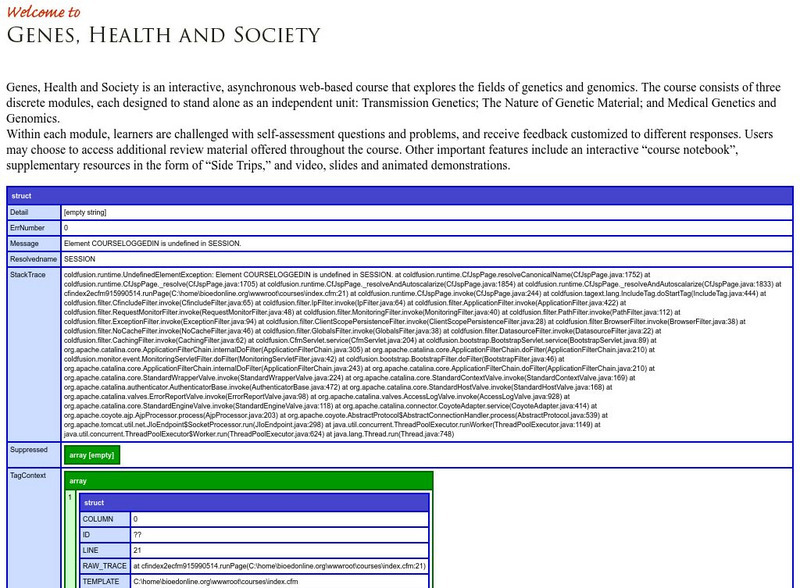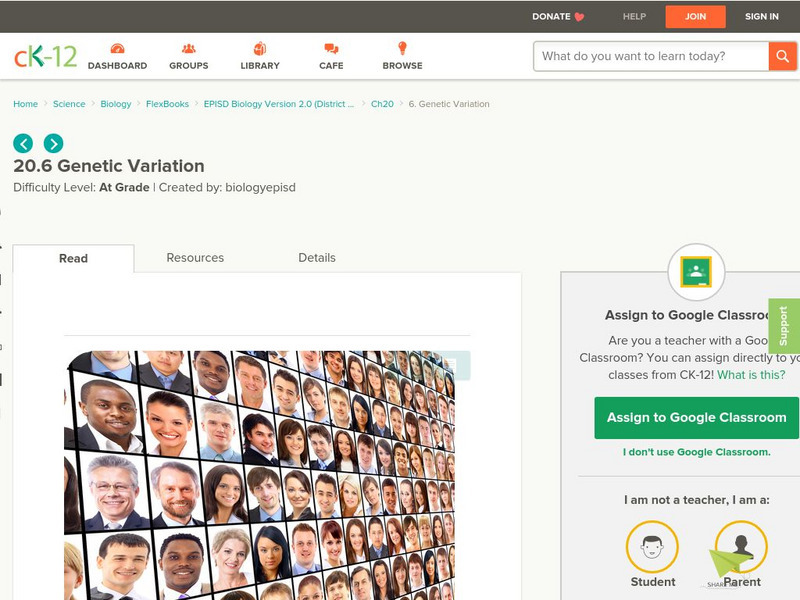Hi, what do you want to do?
Towson University
Transformation Lab
Transform your class' understanding of genes and antibiotic resistance with the Transformation Lab. Junior geneticists create and observe their own resistant strains of E. coli through research, discussion, and experimentation. The...
Biology Corner
Human Genetics
Explore how our chromosomes work to define human attributes. A complete unit presentation includes topics such as genetic disorders, blood typing, and Punnet squares. Learners answer questions throughout the presentation to apply the...
University of Colorado
Punnett Squares with Piebald Deer
Explore the science behind Earth's amazing diversity of life with this lesson on genetics. Looking at specific traits in piebald deer, carnations, and roan cattle, young scientists use Punnett...
Curated OER
Form and Observation
Use a familiar song and adorable baby animal pictures to teach youngsters about genetic variation. Begin by listening to "Twelve Variations on 'Ah vous dirai-je Maman,'" which you will need to find online (there are several versions...
Curated OER
AP: Chapter 23: The Evolution of Populations
How and why do populations change over time? AP biology aces explore this question by completing this assignment. They write the answers to 21 questions regarding population genetics, stability, genetic drift, polymorphism, and...
Curated OER
Adaptations to Niches and Habitats
Life science learners measure and record traits of seeds, leaves, and their own hands and then graph the data to find a continous distribution curve. They compare and color diagrams of seven different animals' forelimbs (not included),...
Curated OER
Gene Switches- A Model
Students explore genetic variation within a population. In this genetic adaptation instructional activity, students investigate the reasons contributing to genetic adaptation. Students collaborate and analyze DNA models. Multiple...
Curated OER
How Evolution Works
Students work in groups to investigate and present genetic variation, adaptation, and sexual selection as it relates to evolution. In this evolution instructional activity, students watch a video discuss how the human eye could evolve...
Curated OER
Human Genetics-- Class Tally: Do You Have a Hitchhiker's Thumb?
In this science activity, students study diversity in human genetics by participating in a class survey and generating a tally graph. Students are asked if they have a "hitchhiker's thumb" and the results are displayed on the tally...
Curated OER
Measuring Biodiversity
Young scholars explore a few key concepts associated with measuring biodiversity. They are told that biodiversity can be measured in a number of ways. Genetic diversity is a measure of the genes represented in the sample. Ecosystem...
Curated OER
Clipbirds
Learners attempt to pick up various objects with a wide variety of beaks, including scissors, spoons, etc.
Curated OER
Natural Selection: Exploring the 'Ohi'a Common Garden
Seventh graders examine natural variation by visiting the Ohi'a Common Garden in Volcano, Hawaii. In this natural selection lesson, 7th graders study background information about phenotypes, genotypes, and phenotypic plasticity before...
Curated OER
The Acetate Animal Hunt
Students determine which adaptations allow an organism to survive and reproduce in a certain environment. Students act as "predators" to pick up acetate discs "prey" scattered around the classroom. Students list the number found, the...
Curated OER
Genetic Variation
Learners study families and their genetics. In this investigative lesson students explain how variations in genetics can be harmful and how some can help with survival.
Curated OER
Reproduction and Development
In this development worksheet, students compare the characteristics of mitosis and meiosis. Students review the male and female reproductive organs and their functions. This worksheet has 4 graphic organizer, 6 short answer, and 16 fill...
Curated OER
Natural Selection
Students observe, measure and record variations that may be due to genetic inheritance. They look at the length of seeds for germinating pinto and lima beans and measure the distance between eyes in humans. They graph and discuss the...
Curated OER
We are where and what we eat
Students explore concepts of plants they eat, where and how they grow and are introduced to genetic diversity. They examine seed characteristics, look at their different sizes, shapes and germination time. They also set up seeds to...
Curated OER
Natural Selection in Protected And Unprotected Populations
Studnets compare how two elephant seal populations fare during successive generations. They participate in a simulation using a card game to look at the differences in two populations, one that is protected from mortality by human...
Curated OER
Of Mice and Moths
Learners study the concept that genetic variation of offspring contributes to population control. They create a presentation showing natural selection and survival of the fittest.
PBS
Pbs Learning Media: Sweaty T Shirts and Human Mate Choice
This video segment from Evolution: "Why Sex?" explores the "sweaty T-shirt experiment," which showed that humans may unconsciously be drawn toward a specific kind of genetic variation in a mate.
BioEd Online
Bio Ed Online: Genes, Health, and Society
A web-based course which allows students to explore the fields of genetics and genomics. The three course modules are transmission genetics, the nature of genetic material, and medical genetics and genomics. Use of this resource requires...
CK-12 Foundation
Ck 12: Meiosis
[Free Registration/Login may be required to access all resource tools.] How do you make a cell with half the DNA? Meiosis. This activity outlines the phases of meiosis, provides an overview of sexual reproduction, and describe how...
CK-12 Foundation
Ck 12: Genetic Variation in Organisms
Genetic variation helps ensure the survival of a species. It is this variation that is the essence of evolution. Without genetic differences among individuals, "survival of the fittest" would not be likely. This activity discusses how...
CK-12 Foundation
Ck 12: Episd: Genetic Variation
[Free Registration/Login may be required to access all resource tools.] How does genetic variation protect species from extinction? Understand sexual reproduction and the importance of both random fertilization and independent assortment.




























